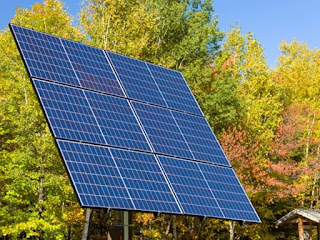Solar cells use the energy in sunlight to produce electricity. Thus, solar cell is device which converts solar energy (or sun's energy) directly into electricity. Since solar energy is also called sunlight energy, so we can say that a solar cell converts sunlight energy into electrical energy. We will now discuss the solar cell in somewhat detail.
A solar cell is usually made from silicon. A simple solar cell consists of sandwich of 'silicon- boron layer' and a 'silicon-arsenic layer'. The amount of boron and arsenic present in the two silicon layers is, however, very small. A small piece of wire is soldered into the top of upper layer of cell and another piece of wire is soldered at the bottom of the lower layer (to tap the current).
The solar cell is covered with a glass cover or a transparent plastic cover for protection. When sunlight falls on the surface of solar cell, it makes the loosely held electrons in the silicon atoms movie due to which a current begins to flow in the wires connected to the top and bottom of the solar cell. The strength of current produced depends on the brightness of the light and the efficiency of solar cell. A potential difference (or voltage) of about 0.5V is generated between the top and bottom surface of a solar cell. At. Present, the best designed solar cell can generate 240 W/m2 in bright sunlight, with a maximum efficiency of about 25%.
A single cell produce only a small amount of electricity. In those cases where more electrical power is needed, large number of solar cells are is called a solar cell panel'. Thus, a solar cell panel consists of a large number of solar cells joined together in a definite pattern. A solar cell panel can provide much more electric power than a single solar cell. The various solar cells in a solar cell panel are joined together by using connecting wires made of silver metal. This is because silver is the best conductor of electricity. The use of silver for connecting solar celle makes it more expensive but it increase the efficiency of solar cell panels are mounted on specially designed inclined roofs so that more solar energy (or sunlight) is incident on them.
Solar cell panels can provide electricity at the those places where the usal electricity is not available. For example, solar cell panels are used to provide electricity in remote and inaccessible rural area. This electric is used there for lighting purposes, to run radio and television sets and to operate water pumps for irrigation of field. A solar cell panel is being used for running a water pump for irrigation in a distant village. The solar cell panel S has hundred of solar cells joined together. The electricity produced by this solar cell panel is strored in battery B ( by charging it). This battery runs an electric motor M. And finally this cell motor cells panel during the day time can be stored by charging a battery (like a car battery) and then used at night power lights.
The main advantage of solar cells are that they have no moving parts, they require almost no maintenance, and work quite satisfactorily without the use of any light focussing device. Another advantage of solar cells is that they can be set up in remote, inaccessible and very sparsely inhabited areas where the laying of usal power transmission lines is difficult and expensive.
The main disadvantage of solar cells is that are very expensive. This is due to following reasons:
- The special grade silicone needed for making solar cells is expensive
- Silver wire used to interconnected solar cells for making solar cell panel is expensive, and
- The entire process of making solar cells is still very expensive.
Used of solar Cells
- Solar cells are used for providing electricity in artificial and satellite and space probes.
- Solar cells are used for providing electricity to remote, inaccessible and isolated places where normal electricity transmission lines do not exist.
- Solar cells are used for transmission of radio and television programmes in remote areas.
- Solar cells are used for providing electricity to 'light houses'situation in the sea and off- shore oil drilling rig platforms.
- Solar cells are used for operating traffic signals, watches, calculators and toys.
Before we end this discussion on solar energy, we should like to compare the fossil fuels and the sun as sources of energy.
- The sun is a renewable source of energy but fossil are a non- renewable source of energy.
- The sun's energy does not cause any pollution but burning of fossil fuels cause a lot of pollution.
- The sun's energy is available in diffused form (scattered form) but fossil provide energy in concentrated form.
- The sun's energy is available only during the day time when the sun shines but energy of fossil fuels can used all the time.











